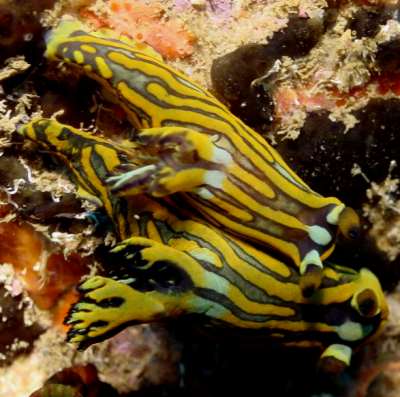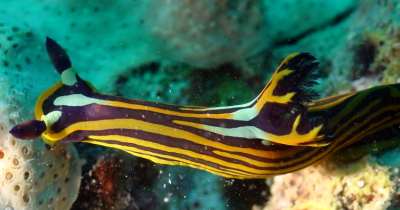

Tambja affinis
(Eliot, 1904)
Order: NUDIBRANCHIA
Suborder: DORIDINA
Superfamily: ANADORIDOIDEA
Family: Polyceridae
Subfamily: Nembrothinae
DISTRIBUTION
Known from the western Indian Ocean [Sth Africa, Tanzania, Mayotte, Sri Lanka] and Thailand
PHOTO
Upper: 'Cowrie', Bentota, Sri Lanka. Indian Ocean. Depth: 23 m. Length: 50 mm. 02 November 2004. rocks covered in fixed invertebrates. Photo: Marina Poddubetskaia. Lower: 'Recif de Peitro', Kongou, Mayotte Island. Indian Ocean. Depth: 11 m. Length: 70 mm. 15 November 2003. rocks. Photo: Marina Poddubetskaia.
The background color ranges from a translucent indigo blue to a dark bluish black. There are a pattern of wide yellow longitudinal bands which in some parts of the pattern change to a milky bluish-green. In specimens with a lighter background colour, the yellow bands are seen to have a thin dark blue-black bordering line (which is obscured in those with a dark blue-black background). There is a broad yellow band around the mantle edge, outlining the anterior end of the body, which runs along each side of the body to just behind the the gills, where the lines on each side meet in the dorsal midline and run posteriorly as a single median line for a short distance. From between the rhinophores a median line runs back to the central gill. The anterior end of that line, between the rhinophores, forms a milky blue-green ovate spot, somewhat wider than the rest of the line. On each side of the dorsum, another yellow line runs from about midway between the gills and the rhinophores, back to the outer gill on each side. These two lines, and the median line, have a milky green-blue patch at the anterior base of the gills. The edge of the foot has a yellow band, and a number of longitudinal yellow lines of similar width run along the sides of the body, sometimes for almost the complete length and sometimes for only a part of the distance.
The rhinophore clubs are dark bluish purple, but in some specimens with a lighter background colour they are translucent yellowish with a deep purplish tip, and basal region. The whole of the rhinophore sheath, not just the edge, is a milky blue-green. There are three large, somewhat branched, gills. The outside edge is yellow and the pinnae are a dark purplish black. There is a thin milky blue line up the inner rachis. This species grows to at least 70 mm in length.
See my earlier message [#14564 ] for the original illustrations of this species. The name Nembrotha affinis has been mistakenly used for animals found in many parts of the Indo-West Pacific. See T. affinis colour group page for a comparison of similarly coloured species.
-
Eliot, C.N.E. (1904) On some nudibranchs from East Africa and Zanzibar. Part V. Proceedings of the Zoological Society of London, 1904(2): 83-105, Pls. 3-4.
-
Pola, M., Cervera, J.L. & Gosliner, T. (2005) Four New Species of Tambja Burn, 1962 (Nudibranchia: Polyceridae) from the Indo-Pacific. Journal of Molluscan Studies, 71: 257-267
-
Yonow, N. (1990) Red Sea Opisthobranchia 3: The orders Sacoglossa, Cephalaspidea, and Nudibranchia: Doridacea (Mollusca, Opisthobranchia). Fauna of Saudi Arabia, 11: 286-299.
ARCHIVE NOTE: An earlier edition of this Fact Sheet [28 April 2003] is available on request.
Authorship detailsRudman, W.B., 2005 (August 15) Tambja affinis (Eliot, 1904). [In] Sea Slug Forum. Australian Museum, Sydney. Available from http://www.seaslugforum.net/factsheet/tambaffi
Related messages
-
Skeleton shrimp on Tambja affinis
From: Vie Panyarachun, March 27, 2009 -
Tambja affinis from Ningaloo Reef, W. Australia
From: Kristin Anderson, December 7, 2006 -
Tambja affinis from South Africa
From: Colin Ogden, September 22, 2005 -
Tambja affinis from Sri Lanka
From: Marina Poddubetskaia Ossokine, August 16, 2005 -
Tambja affinis from Mayotte
From: Marina Poddubetskaia Ossokine, August 16, 2005 -
Original description of Nembrotha affinis Eliot, 1904
From: Bill Rudman, August 16, 2005 -
An update on Tambja in the Indo-West Pacific
From: Bill Rudman, August 16, 2005 -
Tambja affinis from Sudan
From: Jan Reyniers, May 3, 2003 -
Roboastra arika from Thailand
From: Erwin Koehler, January 8, 2002
